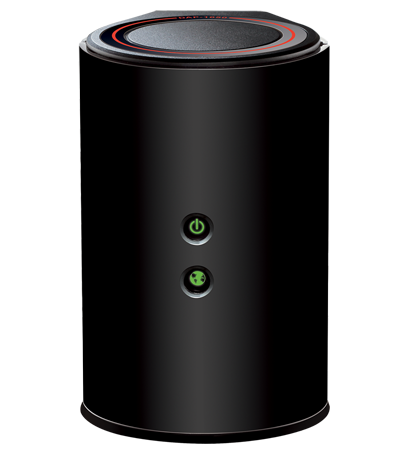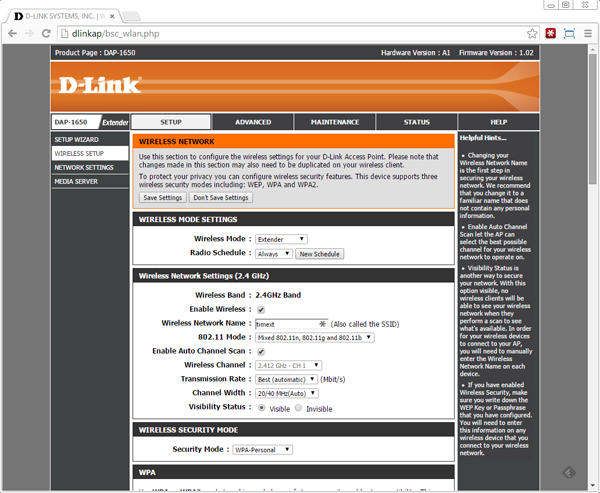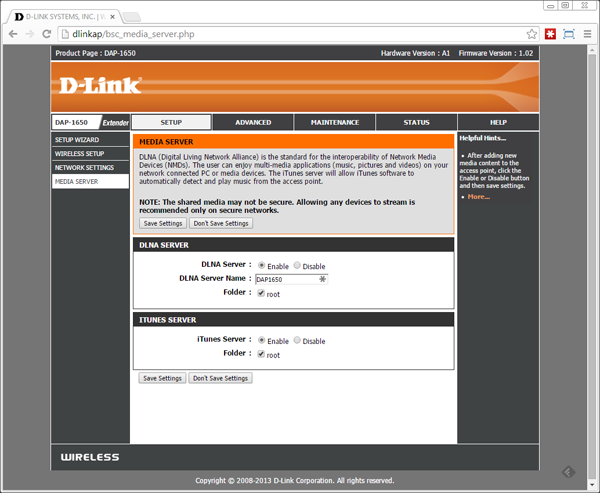AC1200 Wi-Fi Range Extender Round-Up
Today we take four prominent 802.11ac-based range extenders for a test drive to determine the best option for expanding your wireless network.
D-Link DAP-1650
Why you can trust Tom's Hardware
D-Link's DAP-1650 range extender sports the most distinctive profile in our round-up, forgoing the standard flat shape for a cylindrical one. The device's design cues add some height to the hardware, minimizing its desktop footprint. But, as you can imagine, it's also a poor choice for wall mounting.
Specifications
The DAP-1650 features internal antennas for both 2.4GHz and 5GHz frequencies. Four gigabit Ethernet ports run up the back of the device, topped by a USB 2.0 port. There's a power button around back, located below the ports, along with a WPS button between the Ethernet and USB ports and a pinhole Reset button on the range extender's base. The front of the DAP-1650 features two LED indicators—one for power and WPS activity, and a second to show Internet connectivity.
Highlights
Because of its styling, the four gigabit Ethernet ports are stacked vertically with the USB 2.0 port on top. That placement could prove problematic for USB storage devices with short cords. The DAP-1650's use of internal antennas, which could partially explain the vertical chassis design, also sets it apart.
Observations
Whereas Amped Wireless seems to target business customers, D-Link appears to be targeting desktop enthusiasts. The DAP-1650's design arguably makes it less flexible, though some will undoubtedly favor the antenna-less approach. Meanwhile, mainstream capabilities like a USB port are more likely to be used in a home environment than a business setting.
We would have liked to see support for guest networks—a feature that's useful regardless of the customer—but apparently, that didn't make the cut. D-Link does let you schedule the range extender's availability and manage its signal power.
Hardware
Considering all of the external differences between Amped Wireless' REA20 and D-Link's DAP-1650, it's interesting that they're internally similar. The DAP-1650 uses the same 660MHz SoC (Realtek's RTL8197D), and Realtek RTL8192CE and RTL8812AR controllers.
Management
D-Link programmed the DAP-1650's firmware to let it function not only as a range extender, but also as a standard access point or media bridge. The DAP-1650 lets you configure the channels that each wireless band uses, as well as radio schedules to turn the network on and off automatically. CAPTCHA can be turned on or off, depending on how worried you are about the range extender's security.
The USB 2.0 port can act as a media server for music, video or pictures, sending content to network clients supporting iTunes or DLNA. The DAP-1650 is also the only contender that supports the vendor's mobile app for configuration, though it's really only for initial setup. Although Linksys and Netgear offer mobile apps, they don't support the range extenders in today's round-up.
Accessories
D-Link ships the DAP-1650 with a power adapter, Ethernet cable and quick-start guide. The $90 retail price is at the low end of the range we're looking at. Factor that in alongside the flexibility offered by the three usage modes, and this could be a solid option for consumers looking for an entry-level device.
Get Tom's Hardware's best news and in-depth reviews, straight to your inbox.
-
SurfingDude The test results didn't disclose many of the factors affecting WiFi range and performance, I'd like to know more about these. I think the key factors are:Reply
* Nearest other WiFi unit. Interferance from nearby networks can hurt the signal-to-noise ratio.
* Proximity to walls and ground, as reflected signals may affect signal strength up or down.
* Polarization and coverage pattern, as lobes and nulls are inevitable.
The quantities I am really looking for are:
* Maximum usable range in free air and best conditions.
* Data rate in those conditions.
* Attinuation due to each intervening wall or ceiling on both 2.4 and 5 GHz bands.
With this information I might better evaluate which solution is best for a particular situation.
-
littleleo I think it would have been good to add a price/performance metric to the review. I also would have liked to seen the TP-Link ARCHER C5 AC1200 and Asus RT-AC56U 802.11ac included.Reply -
dmitche3 I'm sure that I'm not the o only one who has questions. So let me ask:Reply
1. From a distance of n feet means that the distance from the router and device is only n feet? Why put an extender 5 feet from the router?
2. I don't know if the link to how you tested is meaningful. How far away from the extender were your wireless devices? If your extender is only 5 feet away from your router who is to say that the PC 's wireless device won't differ and add a variable to the equation that is not accounted for?
3. Line of site, walls? If y your office is 50 feet as you described how did you test 75 feet?
-
Jeff_64 LOL zodiacfml!! man that was a good one hly shit. haha fuck, thats actually a really mean troll when i think about it though because the people that are beginners might take you seriously and actually buy a wifi router and will be really confused when they have to run an ethernet cable to it... but pretty good joke nonetheless i guessReply



